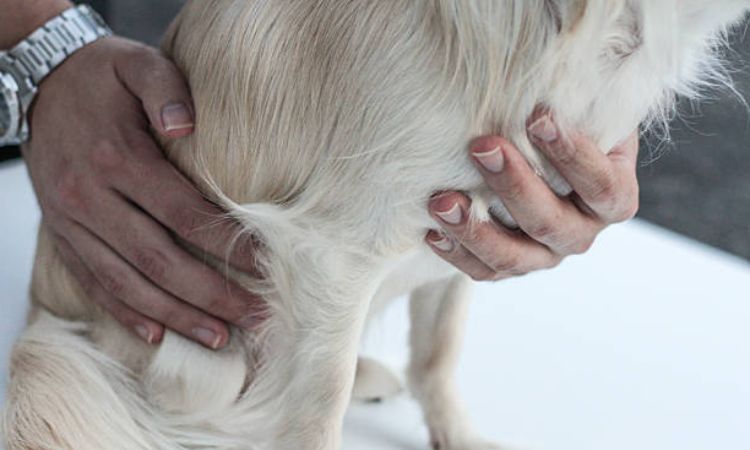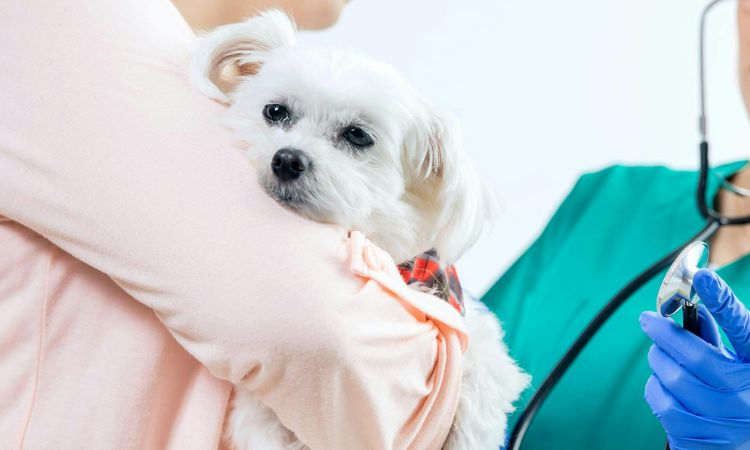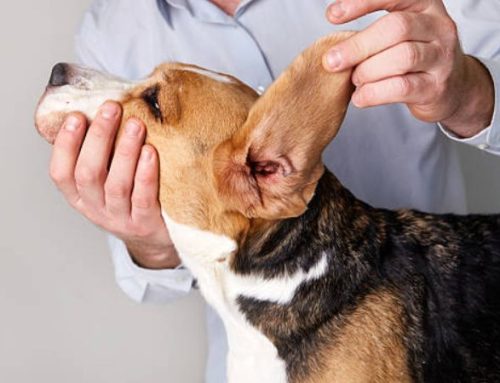Running your fingers through your dog’s fur and suddenly feeling a small, unexpected lump can spark instant worry. Those tiny bumps may be swollen lymph nodes the body’s built-in alarm system signaling that something isn’t quite right.
From minor infections to serious illnesses, lymphadenopathy can reveal more than you might expect. In this guide, Nexus Pets breaks down what swollen lymph nodes mean for your dog, the symptoms to look for, and when it’s time to call the vet.

Causes of Swollen Lymph Nodes
Swollen lymph nodes in dogs can develop for many different reasons, and understanding the underlying cause is crucial for proper diagnosis and treatment. Below are the most common categories of conditions that can lead to lymphadenopathy in dogs:
Infections (bacterial, viral, fungal, and tick-borne diseases)
A wide range of infectious agents can trigger the lymphatic system to react. Bacterial infections such as skin wounds, dental infections, or internal illnesses—often cause nearby lymph nodes to swell as the body attempts to control the spread. Viral diseases, including systemic infections, can also activate the immune response. Fungal diseases like blastomycosis and histoplasmosis may cause generalized or localized lymph node enlargement. Tick-borne illnesses such as Lyme disease or Rocky Mountain spotted fever frequently cause swollen lymph nodes as part of a broader inflammatory reaction.
Inflammatory conditions and immune system disorders
Autoimmune diseases, where the body mistakenly attacks its own tissues, can cause persistent lymph node swelling. Conditions such as autoimmune arthritis or immune-mediated blood disorders may overstimulate lymphocytes, resulting in enlarged nodes even without the presence of infection.
Parasites (fleas, ticks, heartworms)
External parasites including fleas and ticks can trigger chronic irritation and inflammation that leads to lymph node enlargement, especially when infestations are severe. Internal parasites, including heartworms, can also put stress on the immune system and cause swelling in certain lymph nodes depending on the location of inflammation.
Allergies and environmental triggers
Environmental allergens like pollen, dust, mold, or certain foods may provoke a strong immune reaction. In sensitive dogs, this can lead to generalized inflammation and swollen lymph nodes as the immune system ramps up activity in response to perceived threats.
Dental disease and abscesses
Severe gum infections, tooth root abscesses, or untreated periodontal disease commonly cause swelling in the mandibular lymph nodes (under the jaw). These lymph nodes react to the high bacterial load in the mouth as they attempt to control the spread of infection.
Cancer, including lymphoma
Cancer is one of the most serious causes of lymph node enlargement. Lymphoma, a cancer originating in the lymphatic system, is a leading cause of markedly swollen lymph nodes. Other cancers may also spread (metastasize) to the lymphatic system, causing nodes to increase in size as malignant cells accumulate.
Other possible causes (reactive hyperplasia, idiopathic cases)
In some cases, swollen lymph nodes occur simply because the immune system is responding to a minor or hidden stimulus—this is known as reactive hyperplasia. Occasionally, veterinarians may not find a clear cause at all, leading to idiopathic lymphadenopathy, which may resolve on its own or require monitoring.
Symptoms to Watch For
Detecting swollen lymph nodes in dogs early can make a significant difference in diagnosing the underlying cause and initiating timely treatment. While some dogs may show no obvious symptoms aside from the enlarged nodes themselves, there are several key signs pet parents should carefully monitor:
1. Visible or Palpable Lumps Under the Skin
Swollen lymph nodes often present as firm or rubbery lumps beneath the skin. Common locations include under the jaw (submandibular nodes), in front of the shoulders (prescapular nodes), in the armpits (axillary nodes), behind the knees (popliteal nodes), and in the groin area (inguinal nodes). Depending on the cause, nodes may appear as a single lump or multiple enlarged nodes. They can vary in size from a small pea to a grape or even larger if the swelling is severe.
2. Tenderness or Warmth Around the Nodes
Enlarged lymph nodes may feel tender or warm to the touch, indicating inflammation or infection. Dogs may react when the area is gently palpated, showing signs of discomfort such as pulling away, whining, or subtle flinching. Persistent tenderness can be a sign that the lymph nodes are actively fighting infection, inflammation, or other underlying health issues.
3. Changes in Appetite, Energy Levels, or Weight
Swollen lymph nodes are often accompanied by subtle systemic symptoms. Dogs may show decreased appetite, lethargy, or reduced interest in play or exercise. Weight loss can occur over time, particularly if the cause is a chronic infection, cancer such as lymphoma, or another systemic disease. These signs reflect that the dog’s body is under stress and warrants a veterinary evaluation.

4. Additional Warning Signs
In more serious cases, lymphadenopathy may be accompanied by other concerning symptoms, signaling the need for urgent veterinary care:
- Vomiting or nausea – could indicate systemic illness or infection.
- Pale or discolored gums – a potential sign of anemia or blood loss.
- Fever or elevated body temperature – often associated with infection or inflammation.
Monitoring Your Dog
Regularly checking your dog for abnormal lumps and noting any changes in behavior, appetite, or physical condition is critical. Even if the swelling appears mild, it is essential to schedule a veterinary visit to determine the underlying cause. Early detection allows for timely treatment, which can prevent complications and improve outcomes.
When Is It an Emergency? Urgent Signs & Vet Advice
Swollen lymph nodes in dogs, while sometimes caused by minor or self-limiting issues, can also indicate serious health problems that require immediate veterinary attention. Understanding when to act quickly and how to monitor milder cases is crucial for ensuring your dog’s well-being.
Symptoms That Require Immediate Veterinary Attention
Certain signs accompanying lymph node swelling are red flags that should prompt a same-day visit to your veterinarian or an emergency clinic:
- Severe lethargy or collapse: If your dog seems unusually weak, unresponsive, or unwilling to move, it could indicate a systemic infection, severe anemia, or other critical conditions.
- Pale or bluish gums: Changes in gum color may signal anemia, poor circulation, or shock, often associated with infections or cancer.
- Persistent vomiting or diarrhea: These can lead to dehydration and may indicate an underlying infection or systemic disease.
- Fever: An elevated body temperature, especially when combined with swollen lymph nodes, may indicate a serious infection or inflammatory condition.
- Rapidly enlarging lymph nodes: A sudden increase in the size of lymph nodes may indicate aggressive infection or malignant growth, such as lymphoma.
- Pain or severe discomfort: While most lymph node swelling is not painful, tenderness or obvious discomfort can signal infection, abscess formation, or trauma-related inflammation.
If any of these symptoms are present, prompt veterinary evaluation is essential to diagnose the underlying cause and begin treatment without delay.
Monitoring Mild Cases and Knowing When to Escalate
Not all swollen lymph nodes indicate an emergency. Some mild or temporary swelling may be due to minor infections, allergies, or reactive hyperplasia. When swelling is mild and your dog appears otherwise healthy, you can monitor them at home by:
- Checking node size regularly: Gently palpate the affected lymph nodes daily, noting any changes in size, firmness, or tenderness.
- Observing behavior and appetite: Watch for changes in energy levels, eating habits, or water intake.
- Looking for additional symptoms: Be alert for vomiting, diarrhea, coughing, sneezing, or changes in urination.

When to Escalate Care
Even in mild cases, veterinary attention is warranted if you notice any of the following:
- Swelling persists longer than one to two weeks without improvement
- Lymph nodes continue to enlarge or become firm and rubbery
- Your dog develops additional symptoms, such as lethargy, appetite loss, or abnormal discharge
- Signs of pain or discomfort worsen
Vet Advice: Dr. Brad Hinsperger and other veterinarians recommend erring on the side of caution. “It’s always safer to have your dog evaluated promptly if you notice lymph node swelling,” says Dr. Hinsperger. Early diagnosis can distinguish minor, treatable conditions from serious diseases like lymphoma, bacterial infections, or autoimmune disorders.
Treatment Options and Prognosis
Swollen lymph nodes in dogs, or lymphadenopathy, can arise from a variety of causes, each requiring a specific treatment approach. Understanding the options available and the expected outcomes can help dog owners make informed decisions and provide the best care for their pets.
Treatment Options by Underlying Cause
1. Infections (Bacterial, Viral, or Fungal)
- Antibiotics: Bacterial infections are typically treated with antibiotics such as doxycycline or amoxicillin to eliminate the underlying infection.
- Antifungals: Fungal infections like blastomycosis require antifungal medications such as itraconazole.
- Supportive care: In some cases, hydration, nutritional support, and rest are recommended alongside medication.
2. Inflammation and Allergic Reactions
- Anti-inflammatory drugs: Non-steroidal anti-inflammatory drugs (NSAIDs) like firocoxib can help reduce swelling and discomfort.
- Corticosteroids: Medications such as prednisone may be prescribed for severe inflammation caused by immune-mediated conditions.
- Allergy management: Identifying and avoiding allergens, using antihistamines like hydroxyzine, or adjusting diet and environment can prevent lymph node swelling from recurring.
3. Cancer (e.g., Lymphoma)
- Chemotherapy: Drugs such as doxorubicin or combination protocols may be used to treat lymphoma.
- Radiation therapy or surgery: In some cases, local tumors or affected lymph nodes may be surgically removed or treated with targeted radiation.
- Supportive care: Hospitalization, IV fluids, and monitoring for complications may be necessary during aggressive cancer treatment.
4. Parasites (Fleas, Ticks, Heartworms)
- Antiparasitic treatments: Topical or oral medications like fluralaner, heartworm preventatives, or deworming agents are used to eliminate parasites.
- Environmental control: Treating your dog’s living environment for fleas and ticks helps prevent reinfestation.
5. Dental Disease and Abscesses
- Professional dental care: Cleaning, scaling, or extraction of infected teeth can resolve swelling caused by dental infections.
- Abscess drainage: In cases of localized bacterial abscesses, surgical drainage along with antibiotics may be required.
6. Home Monitoring Tips
- Regular palpation: Gently feel your dog’s lymph nodes to track changes in size, firmness, or tenderness.
- Observe behavior: Watch for signs such as lethargy, loss of appetite, fever, vomiting, or pain.
- Hydration and nutrition: Ensure your dog has access to fresh water and a nutritious diet to support immune function.
- Avoid irritants: Keep your dog away from smoke, chemicals, or other environmental triggers that could worsen inflammation.
While mild cases may sometimes resolve on their own, professional veterinary evaluation is essential. Only a veterinarian can determine the exact cause and prescribe the correct treatment, ensuring your dog’s health and preventing potential complications.

Prognosis
- Infections and mild inflammation: Dogs usually recover fully once the underlying cause is treated, with lymph nodes returning to normal size within 2–4 weeks.
- Allergies or mild immune reactions: With proper management, swelling can be minimized, though recurrent episodes may occur if exposure continues.
- Parasite-related swelling: With appropriate antiparasitic treatment, lymph node swelling generally resolves completely.
- Dental disease or abscesses: Swelling typically subsides once infections are treated and dental care is performed.
- Cancer (Lymphoma or metastatic tumors): Prognosis varies depending on the type and stage of cancer. Some dogs respond well to chemotherapy, achieving remission, while others may have a limited lifespan. Swollen lymph nodes may not return to normal size even with treatment.
Prevention and Long-Term Care
Tips for Minimizing Risk
1. Parasite Prevention
- Year-round flea and tick control: Consistent use of veterinarian-recommended preventatives like fluralaner or topical solutions can protect against fleas, ticks, and tick-borne diseases, which are common triggers for lymph node swelling.
- Heartworm prevention: Monthly preventatives help protect dogs from heartworm infestations, which can also contribute to lymphadenopathy.
- Environmental control: Regularly clean and treat areas where your dog spends time to reduce exposure to parasites.
2. Dental Hygiene
- Regular dental care: Professional cleanings, routine brushing, and monitoring for gum disease help prevent oral infections, which can lead to swollen lymph nodes under the jaw.
- Prompt treatment of dental issues: Addressing tooth abscesses, gum infections, or broken teeth early can prevent lymphatic system complications.
3. Routine Veterinary Checkups
- Physical examinations: Regular vet visits allow early detection of lymph node enlargement or other subtle changes in health.
- Preventive screenings: Blood work, urinalysis, and lymph node palpation during annual or semi-annual exams help identify problems before they become severe.
- Vaccinations: Keeping vaccinations up to date helps prevent infections that could cause lymph node swelling.
Importance of Early Detection and Regular Health Monitoring
Early identification of lymph node changes is critical in managing potential health concerns. Swollen lymph nodes may be the first sign of infections, immune-mediated conditions, or even cancer. By monitoring your dog’s behavior, appetite, energy level, and physical condition, you can catch abnormalities sooner.
- Palpation at home: Gently feel your dog’s lymph nodes under the jaw, in the armpits, groin, and behind the knees to detect changes in size, texture, or tenderness.
- Behavioral observation: Watch for lethargy, reduced appetite, fever, or other unusual behaviors that could indicate a developing condition.
- Prompt veterinary consultation: Any persistent or unusual swelling should be evaluated by a veterinarian to ensure timely diagnosis and treatment.
Regular preventive care combined with vigilant monitoring allows many dogs to avoid serious complications and ensures that underlying health issues are addressed promptly. Ultimately, consistent long-term care not only minimizes the risk of swollen lymph nodes but also supports your dog’s overall longevity and quality of life.






